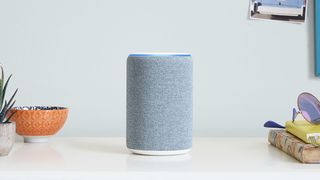How to use Amazon's Alexa devices as a home-wide intercom
More than one Echo? Talk to everyone in your home

If your home is kitted out with Amazon Echo devices, you can now use the "drop in" feature to talk to all of them at the same time. This essentially brings a quick and easy intercom to your home.
Up until now, you could use Amazon's "drop in" feature to send a voice message to only one other Alexa-powered device. Let's say from the Amazon Echo in your living room to the Amazon Echo Dot in your kitchen. You could "drop in" then start a conversation that works both ways.
Now you can do the same thing, but include any other Echo devices too. You can use the Amazon Echo in your living room to talk to the Amazon Echo Dot in your kitchen, the Amazon Echo Show in your kids' room and the second Dot in the hallway all at once. You get the picture.
It's not hard to imagine how this feature could be really handy for families. In the post announcing the new feature, Amazon gives the example of asking “what should we have for dinner?” or “does anyone want anything from grocery store?”
- Read our Amazon Alexa speaker reviews: Echo (2019) | Echo Dot | Echo Dot with Clock | Echo Studio | Echo Show | Echo Show 5
What is "drop in"?
Before we look at the new "drop in" feature, let's have a quick refresher on what you can currently do with a "drop in" call. This is, essentially, a way to start a conversation with another Alexa-enabled device. Which can be in your home or elsewhere.
Athough we say it's a call and it can spark a two-way conversation, the difference between a "drop in" and a call is it doesn't necessarily require an answer. This means if you have "drop in" enabled you could receive and send a voice message.
As you'd expect, you need to approve "drop in" features before you can use them. Otherwise, someone could shout whatever they want at you and your Alexa device would receive it without you doing anything about it.
Get the best Black Friday deals direct to your inbox, plus news, reviews, and more.
Sign up to be the first to know about unmissable Black Friday deals on top tech, plus get all your favorite TechRadar content.
Setting up 'drop in'
To "drop in" among Alexa devices in your home, you'll need to register for Alexa Calling and Messaging. We have a handy guide to help you make phone calls with Alexa here. You can check if you're already registered by going to the Conversations icon in your Alexa app. If you're not asked to register, you're already sorted.
Next up, you'll need to grant yourself the permission to "drop in" on other devices in your home. Go to the Alexa app and head to Conversations > Contacts. Your contact should show up first. Select it and toggle "Allow Drop In" on.
That's it. Now you can "drop in" between two devices in your home. Just say "Alexa, drop in on [name of the device you want to talk with]" to get started.
However, to take advantage of the new feature we've outlined above, the one that allows you to 'drop in' on more than one other Alexa devices at home, you'll need at least three devices with Amazon's Alexa built-in to use it.
If you have Echo devices scattered throughout yout home, you can get started straight away. You'll need to say, “Alexa, drop in on all devices” or "Alexa, drop in everywhere" to start an audio intercom call that everyone in your home can hear.
Home-wide reminders
If you're in the US, Amazon has announced a similar feature for reminders.
In the Alexa app, you can now select "All devices" when you're creating a new reminder. That means the reminder will play across all of your Alexa devices at once.
You'll need to enable this feature to get it to work. To do that, head to Settings > Reminders and opt into “Announce on all devices.”
- How to make phone calls with Alexa: stay in touch with your Amazon Echo speaker
- The best Alexa Skills and commands 2020: the ultimate in Amazon Echo tips and tricks
Becca is a contributor to TechRadar, a freelance journalist and author. She’s been writing about consumer tech and popular science for more than ten years, covering all kinds of topics, including why robots have eyes and whether we’ll experience the overview effect one day. She’s particularly interested in VR/AR, wearables, digital health, space tech and chatting to experts and academics about the future. She’s contributed to TechRadar, T3, Wired, New Scientist, The Guardian, Inverse and many more. Her first book, Screen Time, came out in January 2021 with Bonnier Books. She loves science-fiction, brutalist architecture, and spending too much time floating through space in virtual reality.
